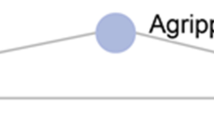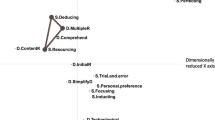Abstract
Network visualizations, a particular kind of data visualization, can be a useful way to visually represent the relationships in real or theoretical social, physical, or biological systems. Network data can be generated and analyzed without being visualized, but the visualizations are often more compelling and may be more easily understood than numbers that summarize network properties. With the growth of network science research across a variety of domains, there is an increased call for basic literacies in networks and the ability to use network visualization as a powerful tool to understand interactions in complex systems. In this chapter, we discuss the current status of the research on network visualization literacy (NVL), how it is measured, what the current research says about NVL across a variety of contexts, ways experts are teaching to develop NVL, and recommendations based on our current understanding of best ways to improve NVL.
Access this chapter
Tax calculation will be finalised at checkout
Purchases are for personal use only
Similar content being viewed by others
References
Sayama, H., Cramer, C., Porter, M. A., Sheetz, L., & Uzzo, S. (2016). What are essential concepts about networks? Journal of Complex Networks, 4(3), 457–474. doi:https://doi.org/10.1093/comnet/cnv028
Börner, K., Balliet, R., Maltese, A. V., Uzzo, S. M., & Heimlich, J. E. (2015). Meaning Making Through Data Representation Construction and Deconstruction. Paper presented at the AERA 2015 Annual Meeting, Chicago, IL.
Maltese, A. V., Harsh, J. A., & Svetina, D. (2015). Data Visualization Literacy: Investigating Data Interpretation Along the Novice—Expert Continuum. Journal of College Science Teaching, 45(1), 84–90.
Eliassi-Rad, T., & Henderson, K. (2010). Literature search through mixed-membership community discovery. In S.-K. Chai, J. Salerno, & P. L. Mabry (Eds.), Advances in Social Computing: Third International Conference on Social Computing, Behavioral Modeling and Prediction, SBP10 (pp. 70–78). Bethesda, MD: Springer.
Börner, K., Maltese, A. V., Balliet, R., & Heimlich, J. E. (2016). Investigating Aspects of Data Visualization Literacy Using 20 Information Visualizations and 273 Science Museum Visitors. Information Visualization, 15(3), 198–213.
Card, S., Mackinlay, J. D., & Shneiderman, B. (1999). Readings in information visualization : using vision to think. San Francisco: Morgan Kaufmann Publishers.
Fabrikant, S. I., Montello, D. R., Ruocco, M., & Middleton, R. S. (2004). The Distance-Similarity Metaphor in Network-Display Spatializations. Cartography and Geographic Information Science, 31(4), 237–252.
Ghoniem, M., Fekete, J.-D., & Castagliola, P. (2005). On the readability of graphs using node-link and matrix-based representations: a controlled experiment and statistical analysis. Information Visualization, 4(2), 114–135. doi:https://doi.org/10.1057/palgrave.ivs.9500092
Bennett, C., Ryall, J., Spalteholz, L., & Gooch, A. (2007). The Aesthetics of Graph Visualization. In D. W. Cunningham, G. Meyer, & L. Neumann (Eds.), Computational Aesthetics in Graphics, Visualization, and Imaging (pp. 57–64): The Eurographics Association.
Fabrikant, S. I., & Montello, D. R. (2008). The effect of instructions on distance and similarity judgements in information spatializations. International Journal of Geographical Information Science, 22(4), 463–478. doi:https://doi.org/10.1080/13658810701517096
Fabrikant, S. I., Ruocco, M., Middleton, R., Montello, D. R., & Jörgensen, C. (2002). The first law of cognitive geography: Distance and similarity in semantic space. Paper presented at the GIScience 2002, Boulder, CO.
Ware, C. (2013). Information visualization: perception for design (3rd ed.). Waltham, MA: Morgan Kaufmann Publishers.
Börner, K., Chen, C., & Boyack, K. W. (2003). Visualizing knowledge domains. Annual Review of Information Science and Technology, 37(1), 179–255.
Brandes, U. (2001). A Faster Algorithm for Betweenness Centrality. Journal of Mathematical Sociology, 25, 163–177.
Purchase, H. C. (1997). Which aesthetic has the greatest effect on human understanding? Paper presented at the Graph Drawing. GD 1997. Lecture Notes in Computer Science, vol 1353.
Purchase, H. C. (2000). Effective information visualisation: a study of graph drawing aesthetics and algorithms. Interacting with Computers, 13(2), 147–162.
Purchase, H. C., Carrington, D., & Allder, J. (2002). Empirical evaluation of aesthetics-based graph layout. Empirical Software Engineering, 7(3), 233–255.
Purchase, H. C., Cohen, R. F., & James, M. I. (1997). An experimental study of the basis for graph drawing algorithms. Journal of Experimental Algorithmics, 2, No. 4. doi:https://doi.org/10.1145/264216.264222
Ware, C., Purchase, H. C., Colpoys, L., & McGill, M. (2002). Cognitive measurements of graph aesthetics. Information Visualization, 1(2), 103–110. doi:https://doi.org/10.1057/palgrave.ivs.9500013
Huang, W. (2013). An aggregation-based overall quality measurement for visualization. Retrieved from https://arxiv.org/abs/1306.2404
Huang, W. (2014). Evaluating overall quality of graph visualizations indirectly and directly. In W. Huang (Ed.), Handbook of Human Centric Visualization (pp. 373–390). New York: Springer-Verlag.
Huang, W., Eades, P., Hong, S.-H., & Lin, C.-C. (2013). Improving multiple aesthetics produces better graph drawings. Journal of Visual Languages & Computing, 24(4), 262–272. doi:https://doi.org/10.1016/j.jvlc.2011.12.002
Huang, W., & Huang, M. L. (2011). Exploring the relative importance of number of edge crossings and size of crossing angles: A quantitative perspective. International Journal of Advanced Intelligence, 3(1), 25–42.
Huang, W., Huang, M. L., & Lin, C.-C. (2016). Evaluating overall quality of graph visualizations based on aesthetics aggregation. Information Sciences, 330, 444–454.
Cleveland, W. S., & McGill, R. (1985). Graphical perception and graphical methods for analyzing scientific data. Science, 299(4716), 828–833.
Heer, J., & Bostock, M. (2010). Crowdsourcing graphical perception: using mechanical turk to assess visualization design. Paper presented at the Proceedings of the SIGCHI Conference on Human Factors in Computing Systems, New York, NY, USA. http://dl.acm.org/citation.cfm?doid=1753326.1753357
Uzzo, S., & Siegel, E. (2010). Connections: The Nature of Networks, Communicating Complex and Emerging Science. In A. Filippoupoliti (Ed.), Science Exhibitions, Communication and Evaluation. Edinburgh: MuseumsEtc.
Cohen, S. (2002). Connections The Nature of Networks: Front End Evaluation. Retrieved from Program Evaluation and Research Group:
Rothenberg, M., & Hart, J. (2006). Analysis of Visitor Experience in the Exhibition Connections: the Nature of Networks at the New York Hall of Science. Retrieved from Northampton, MA:
National Governors Association Center for Best Practices, & Council of Chief State School Officers. (2010). Common Core State Standards. Retrieved from http://www.corestandards.org/
NGSS Lead States. (2013). Next Generation Science Standards: For States, By States. Washington, DC: The National Academies Press.
Cramer, C., Sheetz, L., Sayama, H., Trunfio, P., Stanley, H. E., & Uzzo, S. (2015). NetSci High: Bringing Network Science Research to High Schools. Paper presented at the Complex Networks VI: Proceedings of the 6th Workshop on Complex Networks CompleNet 2015, New York.
Faux, R. (2015). Evaluation of the NetSci High ITEST Project: Summative Report. Retrieved from Boston:
Börner, K. (2015). Atlas of knowledge: Anyone can map. Cambridge, MA: MIT Press.
CNS Center at Indiana University. (2017). IVMOOC: Information Visualization MOOC 2017. Retrieved from http://ivmooc.cns.iu.edu
Börner, K., & Polley, D. E. (2014). Visual Insights: A Practical Guide to Making Sense of Data. Cambridge, MA: The MIT Press.
Sci2 Team. (2009). Science of Science (Sci2) Tool. Indiana University and SciTech Strategies, http://sci2.cns.iu.edu.
Acknowledgments
This work was partially supported by the National Institutes of Health under awards P01 AG039347 and U01CA198934 and the National Science Foundation under awards NCSE 1538763, EAGER 1566393, NRT 1735095, AISL 1713567, and NCN CP Supplement 1553044. Any opinions, findings, and conclusions or recommendations expressed in this material are those of the author(s) and do not necessarily reflect the views of the National Science Foundation.
Author information
Authors and Affiliations
Editor information
Editors and Affiliations
Rights and permissions
Copyright information
© 2018 Springer International Publishing AG, part of Springer Nature
About this chapter
Cite this chapter
Zoss, A., Maltese, A., Uzzo, S.M., Börner, K. (2018). Network Visualization Literacy: Novel Approaches to Measurement and Instruction. In: Cramer, C., Porter, M., Sayama, H., Sheetz, L., Uzzo, S. (eds) Network Science In Education. Springer, Cham. https://doi.org/10.1007/978-3-319-77237-0_11
Download citation
DOI: https://doi.org/10.1007/978-3-319-77237-0_11
Published:
Publisher Name: Springer, Cham
Print ISBN: 978-3-319-77236-3
Online ISBN: 978-3-319-77237-0
eBook Packages: EducationEducation (R0)




